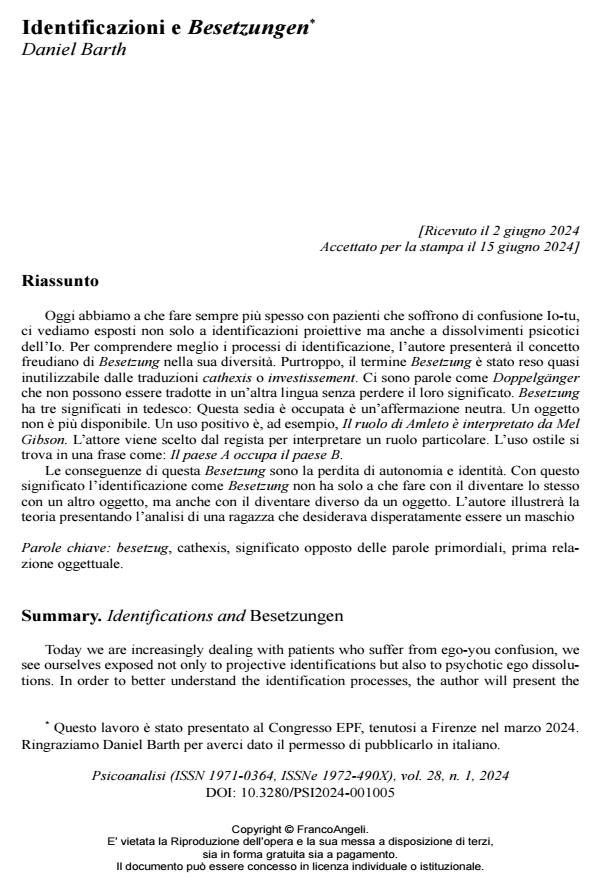Identificazioni e Besetzungen
Titolo Rivista PSICOANALISI
Autori/Curatori Daniel Barth
Anno di pubblicazione 2024 Fascicolo 2024/1
Lingua Italiano Numero pagine 13 P. 59-71 Dimensione file 185 KB
DOI 10.3280/PSI2024-001005
Il DOI è il codice a barre della proprietà intellettuale: per saperne di più
clicca qui
Qui sotto puoi vedere in anteprima la prima pagina di questo articolo.
Se questo articolo ti interessa, lo puoi acquistare (e scaricare in formato pdf) seguendo le facili indicazioni per acquistare il download credit. Acquista Download Credits per scaricare questo Articolo in formato PDF

FrancoAngeli è membro della Publishers International Linking Association, Inc (PILA)associazione indipendente e non profit per facilitare (attraverso i servizi tecnologici implementati da CrossRef.org) l’accesso degli studiosi ai contenuti digitali nelle pubblicazioni professionali e scientifiche
Oggi abbiamo a che fare sempre più spesso con pazienti che soffrono di confusione Io-tu, ci vediamo esposti non solo a identificazioni proiettive ma anche a dissolvimenti psicotici dell’Io. Per comprendere meglio i processi di identificazione, l’autore presenterà il concetto freudiano di Besetzung nella sua diversità. Purtroppo, il termine Besetzung è stato reso quasi inutilizzabile dalle traduzioni cathexis o investissement. Ci sono parole come Doppelgänger che non possono essere tradotte in un’altra lingua senza perdere il loro significato. Besetzung ha tre significati in tedesco: Questa sedia è occupata è un’affermazione neutra. Un oggetto non è più disponibile. Un uso positivo è, ad esem-pio, Il ruolo di Amleto è interpretato da Mel Gibson. L’attore viene scelto dal regista per interpretare un ruolo particolare. L’uso ostile si trova in una frase come: Il paese A occu-pa il paese B. Le conseguenze di questa Besetzung sono la perdita di autonomia e identità. Con questo significato l’identificazione come Besetzung non ha solo a che fare con il diventare lo stesso con un altro oggetto, ma anche con il diventare diverso da un oggetto. L’autore illustrerà la teoria presentando l’analisi di una ragazza che desiderava disperatamente essere un maschio
Parole chiave:besetzug, cathexis, significato opposto delle parole primordiali, prima relazione oggettuale.
- Abraham K. (1909). Bericht über die österreichische und deutsche psychoanalytische Literatur bis zum Jahre 1909. Jahrbuch für psychoanalytische und psychopathologische Forschung, 1: 575–594.
- Abraham K. (1924). A short study of the development of the libido. In: Selected Papers on Psycho-Analysis, pp. 418–501.
- Balint M. (1979). The Basic Fault. London/New York: Tavistock Publications.
- Brandt L.W. (1961). Some Notes on English Freudian Terminology. Journal of the American Psychoanalytic Association, 9: 331–339. DOI: 10.1177/00030651610090020
- Brill A.A. (1913). Freud’s The Interpretation of Dreams (translation) London: George Allen and Unwin (cited from: Steiner R. (1991): To Explain our Point of View to English Readers in English Words. International Review of Psychoanalysis, 18: 351-392).
- De Senarclens B. (2022). Le défi des Etats Limites. Regard clinique et théorique. Paris: Editions Campagne Première.
- Erikson E. H. (1956). The concept of ego identity. Journal of the American Psychoanalytic Association. 4: 56-121. DOI: 10.1177/00030651560040010
- Erlich H. S. (1990). Boundaries, Limitations, and the Wish for Fusion in the Treatment of Adolescents. Psychoanalytic Study of the Child, 45: 195-213. DOI: 10.1080/00797308.1990.1182351
- Ferenczi S. (1933). Sprachverwirrung zwischen Erwachsenen und Kind. Internationale Zeitschrift für Psychoanalyse, 19, 1-2: 5-15.
- Ferro A. (2009). Transformations in Dreaming and Characters in the Psychoanalytic Field. Int. J. Psycho-Anal., 90, 2: 209-230.
- Fonagy P. (2008). A Genuinely Developmental Theory of Sexual Enjoyment and its Implications for Psychoanalytic Technique. J. Amer. Psychoanal. Assn., 56, 1: 11-36. DOI: 10.1177/000306510731302
- Freud S. (1893). Studien über Hysterie. In: GW, vol. 1, pp. 99 -251.
- Freud S. (1900). Traumdeutung. In: GW, vol. 2/3.
- Freud S. (1910). Über den Gegensinn der Urworte. In: GW, vol. 8, pp. 214-221.
- Freud S. (1912). Zur Dynamik der Übertragung. In: GW, vol. 8, pp. 364-374.
- Freud S. (1914). Zur Einführung des Narzißmus. In: GW, vol. 10, pp. 137-170.
- Freud S. (1915a). Das Unbewusste. In: GW, vol. 10, pp. 264-303.
- Freud S. (1915b). Trauer und Melancholie. In: GW, vol. 10, pp. 428-446.
- Freud S. (1923). Das Ich und das Es. In: GW, vol. 13, pp. 237-289.
- Green A. (1977). Conceptions of Affect. Int. J. Psycho-Anal., 58: 129-156.
- Hegel G.W.F. (1807): Phänomenologie des Geistes. In: Werke in zwanzig Bänden, Bd. 3, Frankfurt am Main: Suhrkamp, 1970.
- Hurry A. (1986). Rezension zu: Gregorio Kohon (ed): The British School of Psychoanalysis: The Independent Tradition. Journal of Child Psychotherapy, 12: 127–129.
- Kestemberg E. (1999). L’adolescence à vif. Paris: Puf.
- Klein M. (1932): The Psycho-Analysis of Children. Int. Psycho-Anal. Lib., 22: 1–379.
- Laplanche J. (1992). Le Primat de l’autre en psychanalyse. Paris: Flammarion.
- McIntosh D. (1986). The Economy of Desire ‒ Psychic Energy as a Purely Psychological Concept. Psychoanalysis and Contemporary Thought, 9, 3: 405-435.
- Ogden T. (1985). The Mother, the Infant and the Matrix: Interpretations of Aspects of the Work of Donald Winnicott. Contemporary Psychoanalysis, 21: 346-371. DOI: 10.1080/00107530.1985.1074609
- Ogden T. (1989). On the Concept of an Autistic-Contiguous Position. Int. J. Psycho-Anal., 70: 127-140.
- Ornston D.G. (1985). The Invention of Cathexis and Strachey’s Strategy. International Review of Psychoanalysis, 12: 391–398.
- Roussillon R. (2023). The Need for Illusion: Issues and Term. Cannes EPF 2023: Prepublished papers.
- Sandler J. (1990). Anna Freud’s 1952 Harvard University Lectures. Bulletin of the Anna Freud Centre, 13, 4: 249–278.
- Sami A. (1980). Langue arabe et langue mystique; les mots aux sens opposés et le concept d’inconscient. La nouvelle Revue de Psychanalyse, 22.
- Tuckett D. et al. (2024). Knowing What Psychoanalysts Do and Doing What Psychoanalysts Know. Lanham: Rowman & Littlefield Publishers.
- Winnicott D.W. (1956). Primary maternal preoccupation. In: Collected Papers: Through Paediatrics to Psychoanalysis. London: Tavistock.
- Winnicott D.W. (1958). La preoccupazione materna primaria. In: Dalla pediatria alla Psicoanalisi. Firenze: Martinelli, 1975.
- Winnicott D.W. (1965). The Maturational Processes and the Facilitating Environment. Int. Psycho-Anal. Lib., 64: 1–276.
Daniel Barth, Identificazioni e Besetzungen in "PSICOANALISI" 1/2024, pp 59-71, DOI: 10.3280/PSI2024-001005